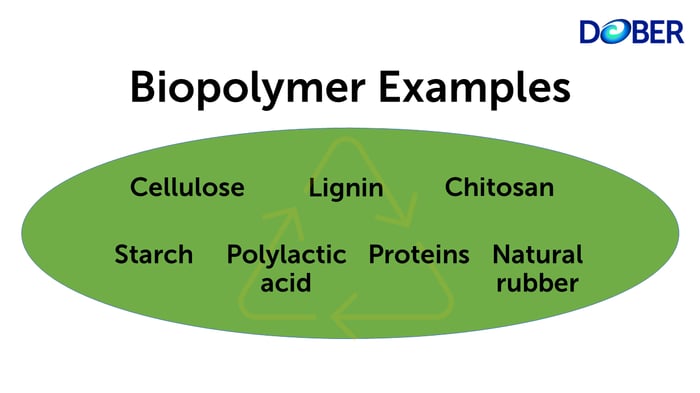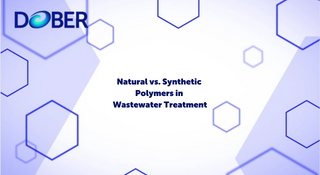What Are Biopolymers?
Biopolymers are a diverse and exciting group of macromolecules that hold great promise toward achieving many of the world's sustainability goals.
From a commercial perspective, biopolymers have gained traction in recent years as sustainability initiatives grow worldwide.
In the U.S., for example, the number of people employed in the biobased products industry reached 3.94 million in 2021, with the industry registering an economic impact of $489 billion.1
So, what are biopolymers?
In this article, we'll answer that question and delve into some biopolymer basics, including:
- A basic definition of biopolymers
- Biopolymer examples
- Why they're important for a wide range of applications
Download Your Copy of the Dober Water Treatment Product Catalog
what are biopolymers?
Biopolymers are natural polymers produced by the cells of living organisms. They consist of monomeric units that are covalently bonded to form larger structures.
These polymers are crucial for various biological processes and functions, and they can be found in all living organisms, including plants, animals, and microorganisms. There are several types of biopolymers, each with a unique structure and function.
Biopolymer Examples
So what are some common examples of biopolymers? We'll list out a few below: 
-
Cellulose, (C₆H₁₀O₅)n: This is the most abundant natural biopolymer, found in the cell walls of plants. It's used to make paper, textiles, and biodegradable plastics.
-
Starch: Extracted from plants like corn and potatoes, starch can be processed into bioplastics used for packaging, bags, and disposable tableware.
-
Proteins: Examples include silk (from silkworms) and wool (from sheep). These biopolymers are used in textiles, as well as in medical applications for drug delivery and tissue engineering.
-
Polylactic Acid (PLA), (C3H4O2)n: Derived from corn starch or sugar cane, PLA is a popular bioplastic used in disposable cutlery, transparent cups, and 3D printing.
-
Chitin and Chitosan: Found in the exoskeletons of crustaceans and insects, these biopolymers are used in water treatment, cosmetics, and as a biodegradable film for food packaging.
What are Biopolymers Used For?
The incredible thing about biopolymers is the sheer vastness of their potential applications.
Biopolymers have a wide range of applications across various fields due to their biocompatibility, biodegradability, and renewable nature. Here are some of the key uses of biopolymers:
Agriculture
In this sector, biopolymers can be used to help boost crop yields and reduce fertilizer needs. In short, biopolymers can promote a more efficient growing process.
According to one 2023 study: "Bio-polymeric hydrogels have several advantages over synthetic hydrogels as they offer good biodegradability and biocompatibility. Bio-polymeric hydrogels are more eco-friendly as compared to synthetic hydrogels. In addition, the use of natural polymers for hydrogel formulation provides a way to utilize our natural resources effectively. Natural hydrogels are a potential tool for agricultural applications as they can retain a large amount of water and allow the controlled release of fertilizers and other agrochemicals." 2
Meanwhile, they can also be used to protect crops against pathogenic fungi. According to the U.S. Department of Agriculture's Agricultural Research Service, fungal pathogens can cause crop loss of up to 10-20% each year, coming at a dollar value of $100-$200 billion.
Oil and Gas
Scale deposition is a major challenge when it comes to upkeep of oilfield equipment. Biopolymers can be used as effective scale inhibitors in these applications, making sure oilfield equipment is well maintained and functioning properly (and safely).
Cooling Tower Water Treatment
Like the previous category, scale formation in cooling towers is also a problem that can lead to reduced heat transfer capability and potential corrosion of surface areas in the system. Like the oil and gas sector, biopolymers can be leveraged as scale inhibitors in this application, making for a sustainable water treatment option.
Medical and Pharmaceutical Applications
Research is ongoing in many exciting areas, but biopolymers have already found uses in a number of medical and pharmaceutical applications.
One example? Drug delivery systems. Biopolymers can be engineered to create drug delivery systems that are more efficient and targeted, reducing side effects and improving therapeutic outcomes. 3
Biopolymers can also be used in tissue engineering, "mainly as healing devices for the temporary implants of the scaffolds for tissue repairing." 4
Similarly, biodegradable sutures are another application in this field.
Packaging
In an effort to reduce plastic waste from packaging, biodegradable packaging is a particularly environmentally friendly application. Polyactic acid (PLA) and starch-based materials can be used to create packaging that decomposes naturally.
This is especially critical given some harrowing numbers from a 2022 OECD report, the Global Plastics Outlook, which stated: "Global plastic waste generation more than doubled from 2000 to 2019 to 353 million tonnes. Nearly two-thirds of plastic waste comes from plastics with lifetimes of under five years, with 40% coming from packaging, 12% from consumer goods and 11% from clothing and textiles."
Textiles
Biopolymers are used to produce biodegradable fibers for clothing and other textile products, promoting sustainability in the fashion industry. According to one study that reviewed biopolymers applications in the textile industry:
"Biopolymers can be used in the textile industry as the constituent base material for the production of filaments and yarns, or to replace harmful chemicals in pre-treatment and finishing operations by providing textile substates with various potential functionalities, such as antibacterial and flame-retardant activity, UV protection, electric conductivity, and hydrophobicity." 5
Food Industry
To extend the shelf life of food products, biopolymers can be used to create edible film coatings. Furthermore, biodegradable utensils, containers and plates can help reduce some of the aforementioned plastic waste. 6
Bioplastics
Biopolymers are used in the production of bioplastics, which are used to make a variety of items from bags to bottles. The idea here is that they offer a more sustainable alternative to traditional petroleum-based plastics.
Electronics
One might not necessarily think of electronic applications for these naturally derived materials, but biopolymers can even be used here, too.
There is some crossover here with the aforementioned medical section, as biodegradable medical devices obviate the need for a surgical operation to remove an implant using traditional materials (as is often needed after a period of time in use). 7
Summary
The aforementioned is just a sampling of potential uses for biopolymers and is not intended as a comprehensive list. In the last decade, the world of science has made significant strides with respect to biopolymer research and application in the real world.
Research continues in many categories: what has been achieved to date likely only represents a sliver of what biopolymers can do.
Biopolymers do face some challenges when compared with traditional synthetics, including current costs (which include initial investment costs to produce biopolymer products), material strength and, on a psychological level, resistance to change among those who have long used traditional materials.
The bottom line is the world of biopolymers presents a seemingly endless sea of possibilities, one that has only just begun to be explored.
As always, if you finish reading and this and think "I'd like to know more," then we always encourage you to reach out to our water treatment team and start a conversation, even if it's not about biopolymers.
References
1. Golden, J.S., Handfield, R.B. Daystar, J., and S. Pires (2024). An Economic Impact Analysis of the U.S. Biobased Products Industry: 2023 Update. Volume V. A Joint Publication of the Dynamic Sustainability Lab at Syracuse University and the Supply Chain Resource Cooperative at North Carolina State University.
2. Tariq Z, Iqbal DN, Rizwan M, Ahmad M, Faheem M, Ahmed M. Significance of biopolymer-based hydrogels and their applications in agriculture: a review in perspective of synthesis and their degree of swelling for water holding. RSC Adv. 2023 Aug 18;13(35):24731-24754. doi: 10.1039/d3ra03472k. PMID: 37601588; PMCID: PMC10437007.
3. Opriș O, Mormile C, Lung I, Stegarescu A, Soran M-L, Soran A. An Overview of Biopolymers for Drug Delivery Applications. Applied Sciences. 2024; 14(4):1383. https://doi.org/10.3390/app14041383
4. Trinath Biswal, Biopolymers for tissue engineering applications: A review, Materials Today: Proceedings, Volume 41, Part 2, 2021, Pages 397-402, ISSN 2214-7853, https://doi.org/10.1016/j.matpr.2020.09.628. (https://www.sciencedirect.com/science/article/pii/S2214785320373533)
5. Patti A, Acierno D. Towards the Sustainability of the Plastic Industry through Biopolymers: Properties and Potential Applications to the Textiles World. Polymers (Basel). 2022 Feb 11;14(4):692. doi: 10.3390/polym14040692. PMID: 35215604; PMCID: PMC8878127.
6. Monjurul Hoque, Sweta Gupta, Ravichandran Santhosh, Irshaan Syed, Preetam Sarkar, 3 - Biopolymer-based edible films and coatings for food applications, Editor(s): Kunal Pal, Indranil Banerjee, Preetam Sarkar, Arindam Bit, Doman Kim, Arfat Anis, Samarendra Maji, Food, Medical, and Environmental Applications of Polysaccharides, Elsevier, 2021, Pages 81-107, ISBN 9780128192399, https://doi.org/10.1016/B978-0-12-819239-9.00013-0. (https://www.sciencedirect.com/science/article/pii/B9780128192399000130)
7. Zhai Zhiqiang, Du Xiaosong, Long Yin, Zheng Heng. Biodegradable polymeric materials for flexible and degradable electronics Frontiers in Electronics, Vol. 3, 2022. https://www.frontiersin.org/articles/10.3389/felec.2022.985681. ISSN 2673-5857.




